Decoupling art and affluence
February 20, 2002 by Harold Cohen
Originally presented as a talk August 2001.
I met my first computer in 1968, when I came from London to take up a one-year visiting professorship at UC San Diego. Four years later I spent a couple of years at the AI Lab at Stanford, and while I was there I started work on a program designed to generate original art. I called it AARON because I assumed I’d be writing a series of programs and it seemed like a good idea to start with a name from the beginning of the alphabet.
There never was a series of programs. I’m still in San Diego and I’m still working on AARON today.
Here’s another way to begin the story.
I started in on a painting career in 1952 and in the succeeding years I showed my work in one of London’s leading galleries, where a six-week exhibition would be seen by two or three hundred people, and in various museums and international shows, where the audiences may have numbered a couple of thousand. That was still the case when I met my first computer in 1968. But it had changed by1985, when I represented the US in the World Fair in Tsukuba (fig. 1). A million people went through the US Pavilion in six months and saw AARON making drawings on one of my drawing machines.
In 1995 I did an exhibition at the Computer Museum in Boston, this time using a painting machine (fig. 2). The size of the walk-in audience was conventionally modest, but the PR people reported that through television programs, syndicated newspaper articles, magazine articles–the entire gamut of media coverage–my work had reached about thirteen million people.
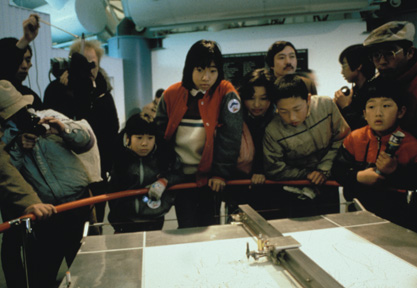
Figure 1. World Fair, 1985.

Figure 2. Computer Museum, 1995.
AARON entered a new public phase early in 2001. In the preceding months, Ray Kurzweil’s people had done an excellent job of preparing AARON for a new life on the web and AARON–the program itself, not its output–became available as shareware (fig 3). Within a few weeks there were tens of thousands of downloads and the number was increasing by two or three hundred a day. That’s the same number that I said would have seen a conventional gallery exhibition thirty years ago.
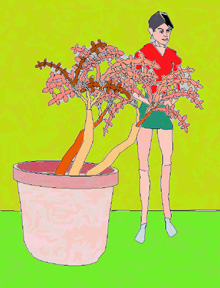
Figure 3. Screen image, 2002.
These numbers aren’t going to surprise anyone in an industry where exponential growth has been the norm for the past decade. Yet I’m only talking here about the growth in the size of a potential audience, not what it takes to reach that audience. The difference is important: art has a cultural role that can’t be served unless it reaches its audience. For that reason, issues of dissemination have never been far behind issues of production for the artist; the two are not as independent of each other as one might imagine.
For artists today using conventional means of production–painting, sculpting–the current technology-driven changes in the available means of dissemination and the resultant growth of potential audience means very little. There is less chance of someone stumbling across one of fifty million web-sites than there is of someone walking into a commercial art gallery by mistake. But artists using the web as a medium rather than a new mode of dissemination may face a similar predicament. What does it mean to use a public medium without a public?
I made a decision at the outset affecting both production and dissemination: on the one hand to produce art by writing a program that produced art and, on the other hand, to exhibit the program producing art rather than exhibiting only the things it produced. Had I not made that decision then in all likelihood I’d still be disseminating my work to two or three hundred people at a time in conventional commercial galleries.
For reasons that I hope to make clear, I’m going to be talking as much about the reasons we do things as about the things we do, so I have to ask why I made that decision. Not because I knew what would happen thirty years later, obviously. It was simply that, in a world where few people knew anything about computers and most of them had it wrong, I didn’t want to present myself as a magician with a magic box. I wanted to clarify, not to mystify. I was acting out of a persistent belief that the health of art is strongly determined by its relationship to the culture it serves and that supports it and I was groping for an appropriate form for that relationship.
But notice that nothing in that decision had any direct bearing on what I wanted the program to do. We’re a long way here from aesthetic considerations.
That decision, made thirty years ago, has left me with a number of unanswered questions, one of which I’m going to try to answer today. As you will see, both the nature of art and the nature of the potential audience figure in my attempted answer.
To introduce the question: I had an email correspondence a while back with someone who said he thought I should make AARON’s source code available on the web. I responded that I’d never hesitated to tell people anything they wanted to know about how the program works so that they could write their own programs, but that AARON itself was my intellectual property and I couldn’t see any reason to give it away. He responded–echoes of linux–that if AARON could be picked up by programmers all over the world we might have generations of AARONs producing original art into the distant future. If I kept it to myself, he said, AARON would come to an end when I stopped working on it.
I replied that he had a point–which he certainly did!–but that I didn’t care for his conclusion. My preference would be to have AAARON modify its own performance over time the way a human artist modifies his own performance over time so that AARON itself could be generating original art into the distant future.
Where’s the problem? In its current state AARON could go on generating original images forever. Yet both the question and my answer presuppose not just the possibility, but the desirability of a different state; one that could be achieved, as it is by human artists, only through continuous modification.
Well, how about re-writing the program so that it randomly changes the values assigned to some of its variables every so often? With hundreds of variables to change, that should cover the search space pretty thoroughly and come up with some interesting possibilities.
That is certainly not what I mean by modifying its own performance over time the way a human artist modifies his own performance over time. The human artist certainly does not wander blindly and randomly through a search space of possibilities, stubbing his toes from time to time on interesting things to do. If you think of “interestingness” as a context-free property–which I do not–then there are always many “interesting” things to do, almost all of which are ignored by the artist just as almost all of the legal moves in a chess game are ignored by the chess master. They fall outside the steadily narrowing window through which the artist surveys the increasingly constrained game to be played out in the future.
The work of any major artist will give you the feeling that he always knew exactly where he was going, but then, any path will look like a path once it has been trodden. Try predicting today what he will do tomorrow and you’ll get a very different understanding of what “moving forward” means. The artist has a notion of direction, not of destination, and he himself can never predict, other than what he certainly will not do, what tomorrow will bring.
As to whether what he does tomorrow will have the cultural role he wants for it; that must depend to a large extent upon the enormously varied demands and the expectations of the culture. The only thing I know about that for sure, after fifty years in the field, is that the aesthetic value of a work constitutes only a part of what the culture wants from the artist, and the size of that part appears to be inversely proportional to what it costs.
There’s an old art world story about a man who has a Picasso original hanging in his living room until one day a friend tells him that it isn’t an original, it’s a print; and he takes it out of the living room and hangs it in the toilet. Less apocryphally and at the other extreme of exclusivity, a Warhol print–a print, not a painting–sold at Sotheby’s last year for four and a half million dollars, bringing to the buyer the same aesthetic value it had when it was first sold–when the artist was still alive and able to make more–probably for a couple of thousand. What was the buyer buying for the other four million plus?
Exclusivity, fashion, whatever… mostly, what the buyers of art are buying is the artist’s reputation, his status. And while status may be awarded temporarily on the basis of a single work or a single exhibition–as Andy Warhol famously said, everyone can be famous for fifteen minutes–it is withdrawn quite soon if the artist is not seen to be moving forward, not developing; if, like AARON in its current state, he merely produced an endless succession of original images without ever changing the terms of reference.
So: not simply change over time; purposeful, self-directed change over time.
Conventionally, we would probably say that purposeful change must necessarily require a program’s assessment of whether or not its output had satisfied some criteria. My own contention, at which I have already hinted, is that the aesthetic criteria that relate to the appearance of individual works are only the final link in a chain of criteria leading far back into the reasons the individual does what he does and believes what he believes. The central question for me, then, is not whether a program can self-modify in order to satisfy internal criteria; it is whether enough of that chain of criteria can ever be internal to a program for it to manifest the self-directed development we expect of human artists.
I don’t think I have an answer to that question. What I do have, however, is the thirty-year history of a continuously developing program and some insight into what was involved in directing it. By way of illustration, I’d like to review a few key points in the program’s history where I can locate particularly important shifts in direction.
Most of this will concern recent developments, but I need to begin by looking at the basis of AARON’s drawing strategy, which was established very early on, because there’s a lot about recent developments that won’t make much sense unless I do.
Briefly, then; the form AARON took initially followed from what seemed rather obvious; that making images for human consumption meant addressing the cognitive processes that enable human beings to attach meaning to marks on flat surfaces. So I concentrated initially (fig. 4) on giving the program the ability to differentiate between closed forms and open forms, figure and ground and so on; the standard things I could get from books. After a few years I sensed that the books weren’t telling me everything I needed to know and I started to examine what actually happens in young children in the first year or two of drawing. They start with a simple motor activity–scribbling; backward and forward, round and round–until one day one of the round and round scribbles migrates outwards to become an enclosing form (fig. 5). Some time later, the scribble disappears, leaving the closed form (fig. 6) as an empty but infinitely malleable container for whatever the individual wants to represent.
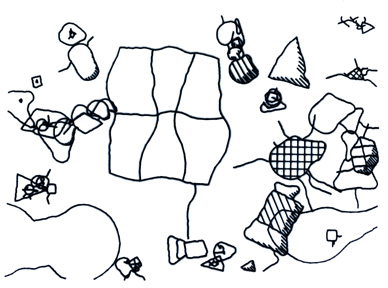
Figure 4. Computer generated drawing, ink on paper, 20 x 30, 1975.
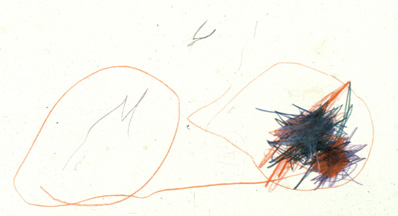
Figure 5. Child’s drawing.
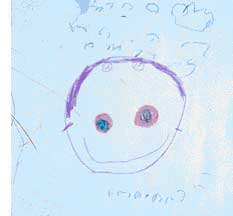
Figure 6. Child’s drawing.
I never succeeded in simulating the child’s performance very well, but simply in terms of the diversity of forms I could see being generated by this two-step strategy–build a core figure, then draw a line around it–the results were astonishing (fig. 7). Compared to any other way I could think to generate forms of that complexity, it was practically a computational free lunch and, even had there not been other reasons for adopting it, I suspect that it would have become AARON’s dominant mode.
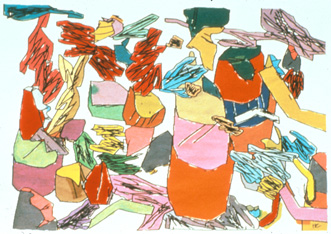
Figure 7. Tapestry, 40 x 60, 1983.
I think it’s important to point out that the strategy has nothing in common with current computer graphics methods, which, like the photography they simulate, deal with the light reflected off the surfaces of things. AARON knows nothing of surfaces. The method for generating its enclosing forms is general enough that it can handle any core figure the program can construct from its data and it has undergone only a single modification in twenty years. That means that as the program moved on to figurative imagery, most attention has been required by the design of the core figures–again, nothing to do with surfaces–that replaced the scribbles in the earlier work.
By the early ‘nineties (fig. 8) I had given AARON some rudimentary knowledge of a few things in the world–figures and plants and very little else–and it was making recognizable images; initially from a sort of two-and-a-half dimensional mode in which it could make plausible drawings of the body from a single viewing position but couldn’t do genuinely 3-dimensional things like drawing an arm crossing in front of the body: and then, later (fig. 9), with a much richer, fully three-dimensional description of the human figure comprised of data representing the parts, as well as procedural knowledge about how the parts articulate, how much the proportions can plausibly vary and something about posture.
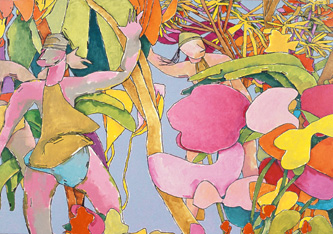
Figure 8. Oil on canvas, 54 x 77, 1988.
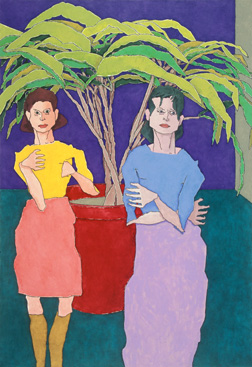
Figure 9. Oil on canvas, 54 x 78, 1997.
The physical data represented key points within the body–articulation points, muscular attachments and so on–and the lines joining them then constituted a set of internal core figures equivalent to the child’s scribble. Each part of the body–upper arm, lower arm, torso, thigh and so on–was rendered as a closed form which resulted from drawing an encompassing line around each core.
That was fine as far as it went, but of course the human viewer doesn’t think of the body as a jointed doll, a collection of discrete parts; visually, the shoulder is an area of transition between the arm and the body, not a boundary, and while we may think of a nose as a conceptual unit it doesn’t offer much in the way of boundaries. In the two-and-a-half dimensional mode (fig. 8) noses were merely markings on the closed form of the head used to indicate the direction the head was facing. But the three-dimensional version was able to give a convincing account of the position of the head simply by the configuration of the outline, and the nose was drawing attention to itself by not being there.
In fact, it was the need to deal with noses that finally triggered the one modification of the underlying drawing mode, which was to have the program leave out parts of the outline–for any part, not just for noses–appropriate to the posture and the angle of view (fig. 10). That sounds simple; but since the functions that generated the outline were quite independent of the data from which the core figure was constructed, the modification required a total overhaul of how the data was represented in the program and a set of new functions to interpret the new form of the data.
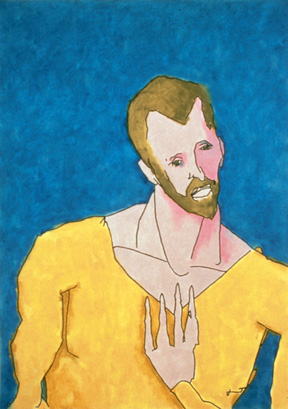
Figure 10. “Theo,” oil on canvas, 24 x 34, 1992.
But hold on, you may say, what’s wrong with drawing the outline of a nose the way you draw the outline of the head? Good question. The answer is that there’s nothing wrong with it; 20th Century art invented a number of drawing conventions that stretched the visual basis of representation a lot further than that. But it’s an important question; because if the program had no reason to think there was anything wrong either with a nose-less head or with a nose as a discrete unit stuck onto the front of the face, then there would be no reason why it should want to do anything about it. Once again, the relevant criteria rested on my own sense of stylistic consistency. Unless I could have given the program a rather sophisticated understanding of stylistic consistency–and there are few words in the vocabulary of art more difficult to understand than the word “style”–AARON could not have found anything wrong with what it had been doing, much less decide what to do about it.
I’ll come back to the issue of drawing, but now I want to turn my attention to color, which has occupied me for most of the past decade. For all of the images I’ve shown you so far I did the coloring myself, either directly on one of AARON’s drawings or by transferring one of its drawings onto canvas and coloring it there. I did it simply because I felt that the images needed color, yet from the very beginning there was a mild but persistent sense of absurdity about the fact that I seemed to be working for the program when I thought the program should be working for me.
So the major change that was initiated in the early ’90’s, leading to AARON’s current role as an independent and capable colorist, actually had a long gestation period in which the pressure was building, not by virtue of something the program was doing wrong, but by virtue of something the program wasn’t doing at all. Why hadn’t I tried to deal with the problem earlier? Quite simply, I didn’t know how. Now I do know how and I also know why I hadn’t known how.
Before that point, I’d thought I was just another expert unable to tell the long-suffering knowledge-engineer about his expertise, though in this case the expert and the knowledge engineer were the same person. It turned out not to be that at all; it was that I had failed to bring into focus something that I now consider so fundamental as to be almost a law of nature. It is that behavior is always shaped–both enabled and constrained–by our physical and our mental resources. Even if I could have described how I did coloring myself–and I had tried long enough to know it was quite unlikely that I could–that description would necessarily have been in terms of my own resources, and they were resources the program didn’t have.
I mean that the human painter has a sophisticated visual system that is capable of registering very small variations in color; and one that permits continuous feedback, reporting the way every new brush stroke modifies the overall color signature of a painting. The result of working within the capabilities provided by that resource is that, almost without exception, human colorists proceed by what I’d call expert trial and error, continuously modifying what has been put down as each new element is added. In fact, almost nobody has ever made a painting by making all the coloring decisions in his head and then writing down the instructions for someone else to execute. Our resources do not include any marked ability to build a reliable, stable internal representation of a color scheme that has never been actualized for the eye to see. In fact, I doubt that there’s much correspondence between the way we imagine color and the way we see it; which in itself would constitute a major reason for the colorist’s trial and error strategy.
AARON doesn’t have a visual system and it isn’t clear that a visual system would help much with respect to coloring for the human viewer unless its color responses closely matched those of the human system. What the program does have is precisely the resource that the human colorist lacks, which is the ability to build a stable internal representation; the ability to design a color scheme “in imagination” as it were, without ever seeing anything on the screen or on the canvas.
The realization that AARON’s resources were different from, but not necessarily inferior to, the human colorist’s resources proved to be the key that unlocked a door for me. Not the solution, obviously, because I had still to devise a rule-based strategy robust enough and flexible enough to provide good performance in an unpredictable range of compositions. But at least I was able to stop asking the entirely irrelevant question about how human colorists use color, and concentrate upon two pertinent questions: firstly, what do human colorists use color for?: and, secondly, what are the properties of color that can be identified and manipulated to any desired end?
The first question–what do we use color for?–has almost as many answers as there are inventive colorists; which isn’t as many as you might think. But it seemed to me that the first and perhaps the only mandatory obligation on the use of color, binding upon all colorists, is that it has to clarify the physical reading of the image. All the rest–emotional content, decorative value, whatever–have to fall into place behind that first obligation. In terms of representational art, that means that color has to help determine the difference between objects and spaces, help to establish boundaries and say where things are in the implied three-dimensional world.
The second question has a simpler answer: there are only three primary properties of color that can be manipulated. One is the hue–where the sample falls on the spectrum. One is it’s purity–how much energy falls within how narrow a part of the spectrum. And one is it’s brightness–regardless of its hue and its purity, where the sample would fall on a scale from black to white. Since the eye functions primarily as a brightness descriminator the most important property of color is not its hue, not its purity, but simply how light or dark it is.
Armed with some clear idea of what the program should be using color for and what it had to work with I was able to formulate a reasonably robust rule-set for determining the profiles of colors to be used for the individual areas of a painting to give adequate visual separation at the boundaries. And by ’93 (fig. 11) I was using not only AARON’s drawings, which hadn’t changed at all during this phase, but also its color schemes, as photographed off the monitor, to make paintings (fig. 12, 13).
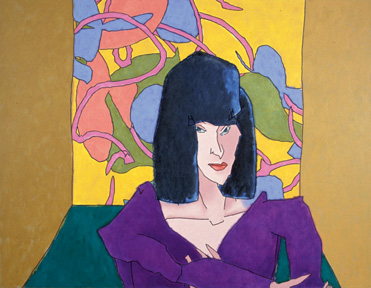
Figure 11. “Clarissa,” oil on canvas, 42 x 54, 1992.
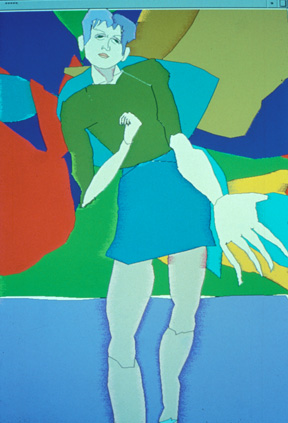
Figure 12. Screen image, 1993.
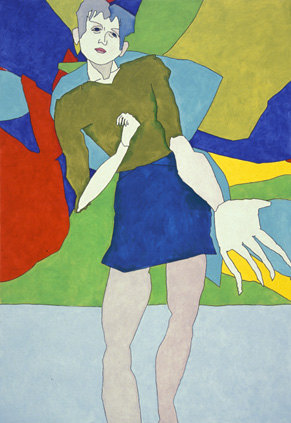
Figure 13. Oil on canvas, 54 x 78, 1993.
The last part of this story is a bit more complicated.
As I emphasized at the beginning, no artist is very far from the problems of dissemination, exhibiting his work. And it didn’t take much, all the time I’d been working on color on the monitor, to recognize that a single monitor in an art gallery doesn’t make much of an exhibition. Given that I’d solved the problem with respect to drawing by building several generations of drawing machines, the answer now–the much too obvious answer–was to build a painting machine.
I won’t go into detail about the hardware, a large xy device that carried a small robot arm on its beam, complete with a simple hand. It could mix its colors from a palette of water-based dyes by having the hand open the taps on the dispensers for measured times. And it could pick up and use brushes of different sizes.
After making a drawing with waterproof black ink the machine would move a cup from one dispenser to another to mix the required color, deposit the cup where the hand could reach it as it moved around the table, pick up a brush and start filling in the shapes. When it had finished with a color it would empty the cup and wash it out ready for the next color, then wash out the brush and start over again. It took about six hours to complete a painting about four feet by six and in a show at the Computer Museum in Boston it did one painting a day for seven weeks.
On the software side, the first problem was to characterize the dyes mixtures, about eleven hundred of them, in terms of the three fundamental properties. But characterizing them was one thing, mapping them onto the rgb specifications generated for the screen another thing entirely. The guns that activate the screen are effectively light sources, so that mixing is additive, whereas physical materials act as filters and remove light. Mixing dyes is subtractive mixing. (fig. 14) You get yellow on the screen by adding red and green, while if you mix red and green pigments you get dirty brown.
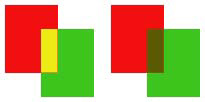
Figure 14. Additive mixing and subtractive mixing.
There was another difference, too, that proved to be much more troublesome.
As I’ve said, the most important property of color is its brightness, which is manipulated on the screen by increasing or decreasing the output of the three guns. Assuming the dyes are being applied over white paper, you increase brightness by dilution, while you can’t decrease brightness at all except by adding a darker dye and thus changing the color.
By the time I’d made and measured the samples of the dye mixtures themselves I had neither the resources nor the inclination to make enough dilution samples for each of those eleven hundred samples to be useful. I made some not very sound assumptions about how the dyes could be grouped and I provided dilution data for the groups rather than for the individual mixtures and the output during the show (fig. 15) varied from very good to clearly incompetent. I realized later that there was a simpler way of establishing dilution, but by then the program was already changing direction.
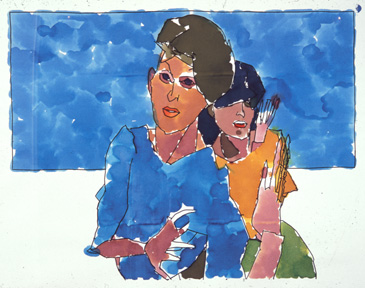
Figure 15. Machine painting, ink and dyes on paper, 53 x 70, 1995.
There were three painting machines in all; the first served only to tell me how little I knew about engineering; the second was the one used in the Computer Museum and the third, the much improved model I’ve been showing you, was filmed for several television programs but never left my studio until it went to its final home in the Museum of Computing History late last year. As part of a questionable balance-sheet of energy expended versus advantage gained, I had to recognize that the better the machine got, the more it risked directing attention away from the program instead of toward it. That risk was already evident in the Computer Museum show, where people were interested in the painting but delighted by the machine washing out its own cups–housework being the high point for robotics, obviously–and it was becoming increasingly apparent as I found more and more people referring to AARON as a robot artist; as I got more and more requests for pictures of AARON rather than pictures by AARON
This is not to say that the painting machine represented a dead end and had no significant role in AARON’s development. For one thing, I hadn’t gone to the trouble of building the machine to have it do simple-minded raster-scan filling and the algorithm I devised for generating the brush movements has become AARON’s standard way of filling in color.
And, to come back to drawing–or, rather, to the relationship between drawing and coloring–the most important gain was the realization that, given black lines to hold the colors in place, the choice of color wasn’t nearly as critical as I had thought it should be. On the machine the lines served a critical physical function; it simply wasn’t possible to have edges established by the colors themselves, since the water-based dyes would run into each other and confuse more than they clarified. Once I was no longer using the machine I could, in principle, do anything I wanted to do. What I wanted–what I had wanted as a painter for several decades–was to have color play a critical role, not merely a supporting role, in the structure of images. The black lines of AARON’s drawing were preventing that happening.
The current version of the program does not draw lines (figure 16) and has gone some way toward that goal. But it was not enough simply to leave out the lines; once they were eliminated, the edges of forms had to be established by the colored brush marks themselves. However, my painting algorithm controlled the path of the brush, not the edge of the brush, and whichever brush the program chose there would always be some concavities in the outlines too small for the brush to get into, which had been left blank in the earlier versions and on the painting machine . The problem wasn’t intractable, but it did involve substantial modifications to the underlying algorithm.
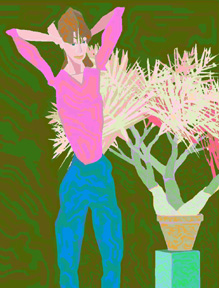
Figure 16. Screen image, 2002.
As to the coloring part of the change; as I indicated earlier, constraining areas of color within black boundary lines minimizes the degree to which the reading depends upon the colors. When you have two patches of color in contact with each other, on the other hand, there are optical effects generated by the color contrast at the edges that were not there before. And in this case the difference was extreme enough that I had to make substantial changes, not to the values assigned to the colors, but to the rules that assigned those values.
That brings us up to date with respect to AARON’s history and now I want to make some general observations.
Firstly: each phase of AARON’s development has involved modifying, but never abandoning, what has gone before. So, for example, AARON still structures its forms the way it has always done, though the delineation no longer shows in the output.
Secondly–and this may be simply another way of saying the same thing–there have been no false starts in AARON’s development. That doesn’t mean that I’ve been clever enough always to pick the right thing to do, but simply that this is a game that has to be played with the cards I’ve dealt myself. Given that human artists don’t suddenly change their style from one day to the next or one decade to the next, we might assume it to be a characteristic of directed development for the human. For the program, I would assume it to be rather difficult characteristic to emulate and, whatever other difficulties might arise, it certainly couldn’t emulate it unless it had appropriate access to previous states of the game.
That rules out AARON in its present form, if not programs in general, because AARON doesn’t have any archival record of its work. It doesn’t have one for the simple reason that I’ve never known what should go into one. As I suggested earlier, if the program is to move forward by assessing its efforts against various criteria, then it needs a representation of those aspects of the work that bear upon the criteria, including the decision history that resulted in the particular example.
Lots of problems here, the principle one being that AARON’s work is intended for human use and its criteria must consequently reflect what the human viewer responds to in an image. That is not the result of a single decision, it rests upon the interaction of thousands of decisions. Even if I were to accept the conventional view that the program would need to be trained by a human expert, it would have no way of knowing in detail what the human expert is responding to when he declares that one image is better than another, because the human expert doesn’t know,
As you can imagine, I’ve frequently been told that that’s exactly the kind of thing neural nets are supposed to do. That leads to the third general observation, which is that all of the changes of direction I’ve described, and all the others I haven’t described, have involved sizeable modification to the program itself, often down to the invention of completely new algorithms. I’ve never done anything that affected the program’s development significantly by adjusting the values of variables.
The fourth observation I want to make, and perhaps the most crucial with respect to my contention, is that no change of direction was ever made because there was anything wrong with the program’s output. There was nothing wrong with the output of AARON’s earliest phase and there is nothing wrong with the colored drawings that are now being generated on tens of thousands of machines around the world. Well, I don’t mean there was nothing wrong exactly; I mean there was nothing wrong aesthetically with the individual images; no failure to satisfy aesthetic criteria internal to the program that might have prompted it to make changes. To restate my original contention; the criteria that have been most in evidence in requiring changes of direction are at the upper end of the chain and external to the program itself.
I’d like to finish up this survey, then, not by looking at individual changes, but by trying to say a little about why AARON exists at all and why it took the path it did.
In all the museum shows I did with AARON using drawing machines, I offered its drawings for sale: $25 for a signed original; an hundreds were sold in places dedicated to showing things that ordinary people could not dream of owning. I’ve discussed the reason for building the drawing machines: I wanted to show what was happening, not just a few examples of the things that fell out in the process. But why on earth did I want to sell drawings at two orders of magnitude less than I could sell my own drawings for in the conventional art world?
You may be inclined to suppose it was an experiment in marketing, but clearly that couldn’t have been the case. I had no reason to suppose that I could sell a hundred of AARON’s drawings for every one of my own. With no precedent to look to, there were no reasons to suppose anything at all, except perhaps that making an anti-elitist move like this one might very well endanger my standing in the conventional art world. Which, of course, it has. After all, I could hardly expect approval for saying that a machine could do what we normally assume only talented human artists can do.
Why would an artist who had spent twenty years of his life making luxury objects for wealthy people feel compelled to make a socio-political move of this sort? I never had anything against wealthy people buying luxury objects–including the ones I made–and I still don’t. On the contrary, and regardless of why they do it, wealthy people are actually fulfilling a rather important role on behalf of the culture; we wouldn’t have museums full of great art unless someone had commissioned it and bought it. I do have to confess to having been quite fed up with an official art establishment that existed, as all establishments do, to maintain what has been established: which, in London at the end of the ‘sixties, included me. But being fed up doesn’t necessarily lead to computing, especially for someone with nothing of the sort in his background and at a time when computing meant sitting up all night punching IBM cards.
I’ll skip any amateur psychoanalytical speculation. Whatever the reasons for AARON’s existence and its history, it’s surely obvious that they are not to be found in the individual works produced by the program, but in my own background, my own history. What, then, would be involved for a program to have its own history of self-directed development?
Now I’m not much of a programmer and writing a program so that it can rewrite itself is way beyond my capacities; most of the time I don’t even know how to rewrite things myself without much stumbling and a great deal of debugging. If my more capable colleagues want to assure me that one can indeed write programs that can figure out new algorithms for themselves, rewrite themselves, debug themselves and assess the results by themselves, I’m quite prepared to believe them.
I am not yet prepared to believe, however, that a program can have the reasons for doing so: that it can embody enough of some equivalent to the chain of criteria that determines what human artists do that it could be capable of the kind of self-directed development I’ve been describing.
On the other hand…
My confidence in the logic behind this conclusion needs to be qualified, for it’s quite possible that I’m not thinking about this in the right way at all. So I think I must end by acknowledging that there may be other ways of thinking about things; and, in the process, clear up what may seem to have been an oversight. I mean that AARON is one of the very few programs in existence with any claim to creativity and I haven’t used the word once. Isn’t creativity, after all, precisely at the core of this discussion?
Creativity is a word I’ve never used if I could avoid it and I’ve certainly never made any such claim on AARON’s behalf. On the contrary, while friends and well-wishers like Margaret Boden and Bruce Buchanan have continued to cite AARON as a prime example of programmed creativity, I’ve maintained steadfastly that it’s nothing of the sort, citing precisely the fact that the program is incapable of the kind of development we would require of a major human artist. Of course, that could itself be regarded as a definition of sorts; one that not too many human artists could satisfy, by the way, and one that may not map easily onto other domains, which spread a long way down from the Einsteins and Michelangelos once we leave the more refined strata of academic research.
If I had to place AARON somewhere on a spectrum with creative napkin folding at one end and general relativity at the other, I would certainly place it well above creative napkin folding, so perhaps its time to soften my hard-nosed position, that AARON is not creative at all, and concede that it’s creative with a small ‘c’ but not Creative with a big ‘C’. That little dance step brings a nagging question into focus, however, and I don’t think we know how to answer it. Is there, in fact, a continuous spectrum from creative napkin folding to general relativity? Is creativity with a small c a small example of Creativity with a big C, or are the two entirely different? If they are entirely different, then we haven’t even begun on the search for programmed Creativity–with a big C–and I certainly don’t have any clue as to how to begin.
If there is a continuum, then that’s another story. I’m reminded of a conversation a long while ago with my good friend Ed Feigenbaum. I’d written something for an exhibition catalog text along the lines that machines couldn’t think, but they were capable of making extremely complex decisions. Ed was quite upset and insisted that machines could think. I objected that he was voicing an article of faith rather than a demonstrable fact and he replied that when machines make much more complex decisions than they were then able to make, we would all say they were thinking and we wouldn’t give the matter another thought.
And so it has come to pass. And it may well be that as AARON becomes more complex, as the range of its abilities and its knowledge of the things in the world and the determinants to what it should do about them becomes much more complex than is now the case and without regard to the nature of the complexity, perhaps even I will be prepared to say that it’s Creative–with a big C–and not give the matter another thought.
I have every reason to hope so, given that I don’t know how else to proceed.
On the other hand… who knows what tomorrow will bring…?